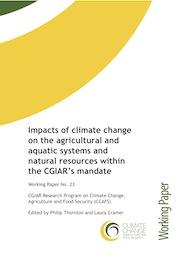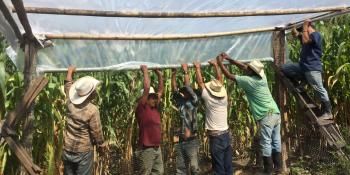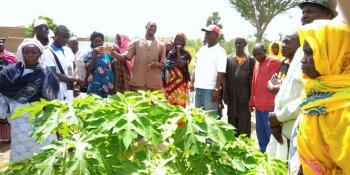A comprehensive summary of climate change impacts on tropical agriculture

Climate change is already having impacts on food systems in the tropics, and in the coming decades it will alter the regional distribution of hungry people. A new working paper from the CGIAR Research Program on Climate Change, Agriculture and Food Security (CCAFS) distils what is known about the likely impacts of climate change on the commodities and natural resources that make up the mandate of the CGIAR and its 15 Centres.
The study, “Impacts of climate change on the agricultural and aquatic systems and natural resources within the CGIAR’s mandate”, contains summaries for 22 mandate commodities and for agroforestry, forests, and water. These summaries, written by scientists at each CGIAR centre, outline the importance of each commodity for food and nutrition security, its biological vulnerability to climate change, and the likely socio-economic vulnerability of the people affected.
 The study shows that there are some crucial gaps in our understanding of the likely impacts of climate change on many key food staples and natural resources in developing countries. Some of these gaps are quite surprising.
The study shows that there are some crucial gaps in our understanding of the likely impacts of climate change on many key food staples and natural resources in developing countries. Some of these gaps are quite surprising.
For example, crops like cassava and yam make critically important contributions to the food security of millions of people and are highly climate-resilient, but along with most other root crops and pulses they have been very little studied in relation to a changing climate.
We also know little about how multiple stressors of animals and plants may combine: in rice, for instance, a combination of heat and salinity stress can lead to additional physiological effects over and above the effects that each stress has alone. Then there are some big knowledge gaps concerning likely impacts of climate change on weed, pest and disease complexes.
We currently have little information on the effects of a changing climate on household food security and livelihoods as well as on the urban populations who rely on cheap food, fuel, water and other necessities.
All this kind of information is needed to help identify and evaluate the trade-offs and synergies associated with particular adaptation and mitigation options in different places.
The study should help the CGIAR and partners to prioritise some of these gaps and give a boost to on-going work on previously neglected crops and collation and re-analysis of the substantial holdings of historical field trial data available at the centres, for example.
There is also a need for further investment in this kind of research, particularly into lesser-known staples, and into understanding how multiple climate-induced stresses combine.
The good news is that CGIAR centers and their partners are working hard to help fill some of these key gaps. For example, CCAFS researchers based at the International Center for Tropical Agriculture (CIAT) have been looking closely at the impacts of climate change on key staple crops in Sub-saharan Africa, using a combination of 24 climate prediction and crop suitability models.
This includes cassava, potato, maize, bean, banana, millet, and sorghum. These studies were published last year in the book Crop Adaptation to Climate Change. CIAT is also investigating climate impacts on important cash crops such as coffee and cocoa, finding that climate change is likely to negatively impact production, which is bad news for western consumers, not to mention thousands of smallholder farmers who rely on these crops to make a living.
The CCAFS working paper is one of the background documents for a review on climate change on agriculture and food security being carried out by the High Level Panel of Experts on Food Security and Nutrition (HLPE) at the behest of the UN Committee on World Food Security (CFS). The HLPE report on Food Security and Climate Change, which was released in June, “calls attention to the urgent need for action at all levels, starting with local communities and extending up to global organizations,” with specific recommendations for all actors.
Download the paper
Thornton, P. and Cramer, L. (eds.). 2012. Impacts of climate change on the agricultural and aquatic systems and natural resources within the CGIAR’s mandate. CCAFS Working Paper 23. Copenhagen, Denmark: CGIAR Research Program on Climate Change, Agriculture and Food Security.
This story was written by Philip Thornton, who coordinates research on Data and Tools for Analysis and Planning for the CGIAR Research Program on Climate Change, Agriculture and Food Security. Dr. Thornton is based at the International Livestock Research Institute (ILRI). For more updates on our ongoing research and reports, like us on Facebook, and follow us on Twitter @Cgiarclimate.


